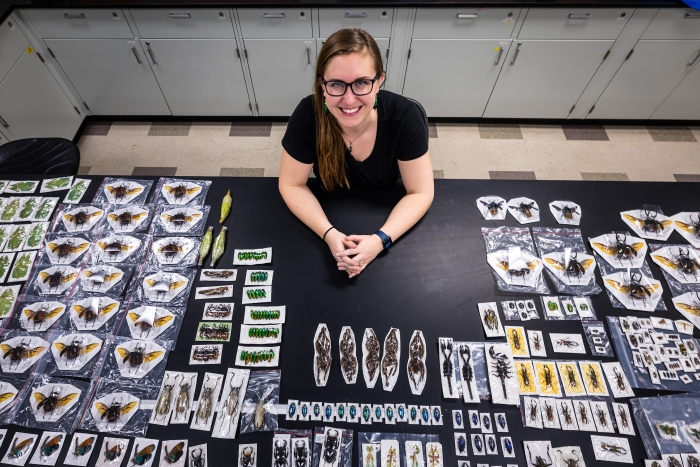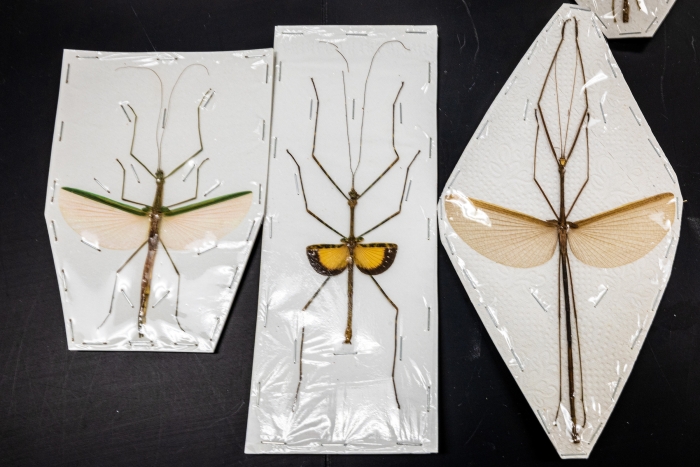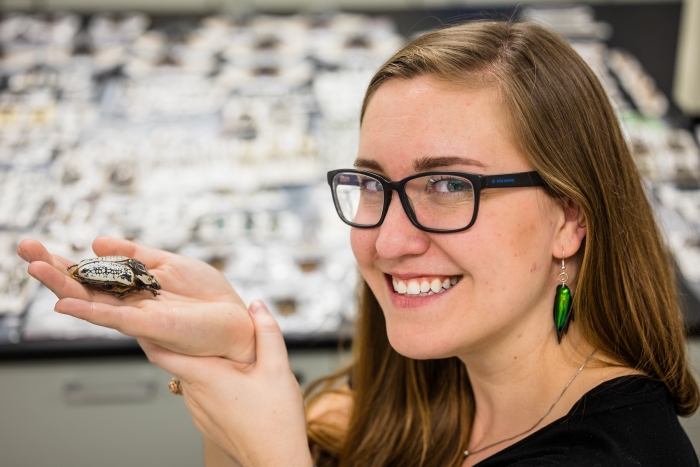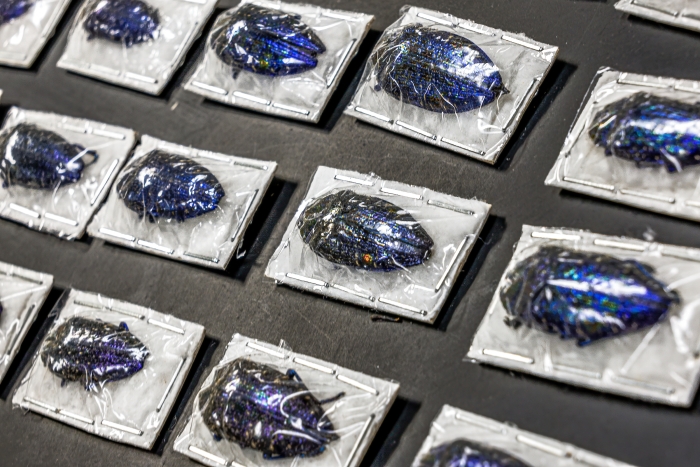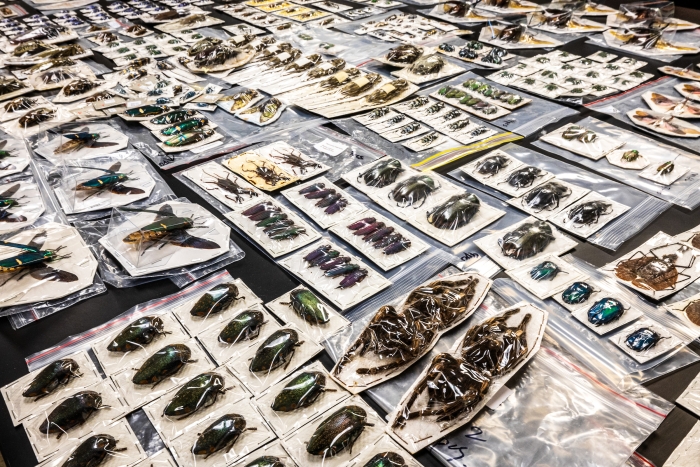Black market bugs find a home at ASU’s forensics school
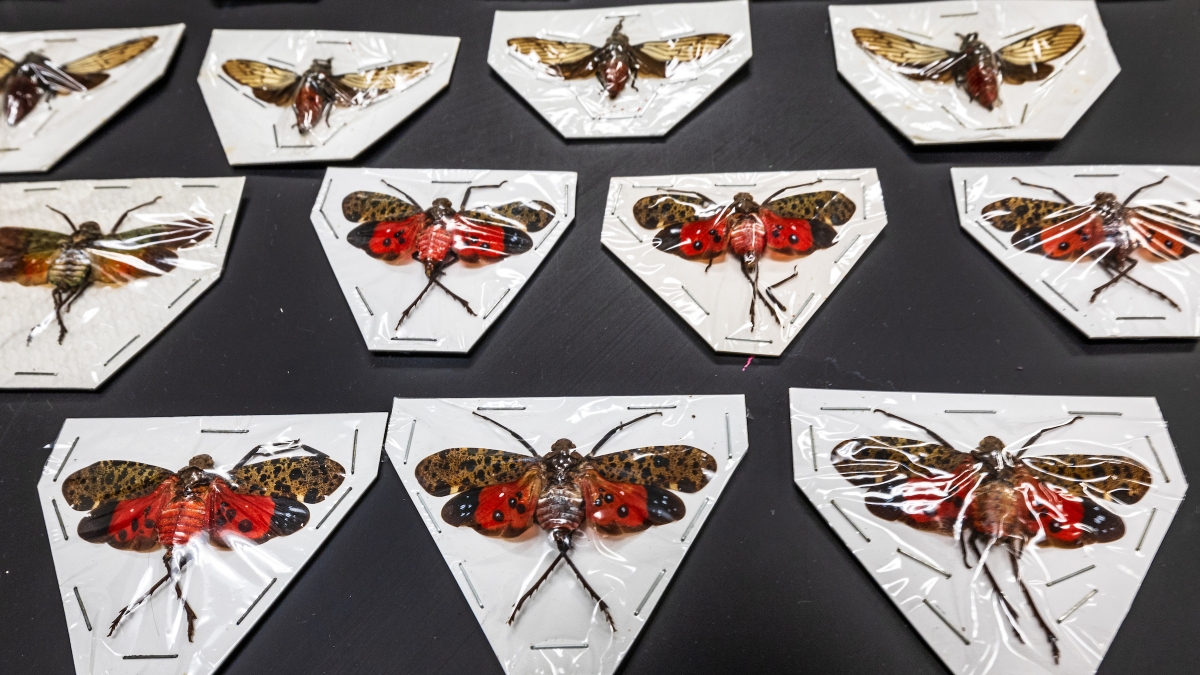
Assistant Professor of forensic entomology Lauren Weidner displays red lantern flies from her collection of more than 3,000 illegally trafficked insects in her West Valley campus lab. Photo by Charlie Leight/ASU News
Arizona State University has recently acquired a rare collection of insects.
The School of Interdisciplinary Forensics is now home to more than 3,000 black market bugs.
“People have no idea that insects are illegally trafficked,” said ASU Assistant Professor Lauren Weidner, the current curator of the collection. “It’s a very lucrative business.”
Weidner, a forensic entomologist on ASU’s West Valley campus, serendipitously stumbled upon the insects on a recent visit to the National Fish and Wildlife Forensics Laboratory in Oregon.
The bugs had been confiscated upon entering the country and were later exiled to the lab — which was to become their final resting spot. That is, until Weidner welcomed them to ASU.
The collection contains insects in a range of sizes, colors and shapes. Some are as small as a shelled sunflower seed, while others are more than six inches long.
A few, like the Marmessoidea rosea, a walking stick bug from Malaysia, seem as soft and delicate as a flower. Others, including variations of the stag beetle, have abdomens that look as hard and strong as a pair of Doc Martens.
They come in an array of colors. Some are iridescent; others, such as the Mexican spider, are a metallic turquoise color. And still others combine shades and patterns that would impress a high-end designer.
“They are just stunning,” Weidner said. “At least to me they are.”
Weidner says insects are among the most illegally smuggled species.
The world’s largest and rarest butterfly, for example — the Queen Alexandra’s birdwing, which has a 10-inch wingspan — can fetch as much as $100,000 on the black market.
Weidner has big plans for the bugs. Over the next year, she and students in her individualized research class will be creating fact sheets for each insect as part of their final project.
The detailed information will help federal agents and local investigators identify illegal insects coming into the country from as far away as Malaysia, Laos and Thailand.
Beyond that, the rare insects will eventually be part of an ASU collection.
But for now, the bugs are scattered among seven boxes in Weidner’s lab — ready to be sorted.
Weidner recently gave ASU News a peak at her prized collection and explained the project that lies ahead.
Editor's note: Answers have been edited for length and clarity.
Question: What was it like for a forensic entomologist to receive 3,000 rare insects?
Answer: I was excited and overwhelmed all at once.
Q: Why are some insects sold on the black market and what makes trafficking them illegal?
A: Honestly, there are so many reasons why someone would want these insects. They can be souvenirs or sold for their parts or used for jewelry and art. For some, they are delicacies while others use them for traditional medicine, religious ceremonies and even witchcraft. But mainly they are exotic pets or rare specimens in a collection.
What this comes down to is people wanting to have what they can’t have. … Insects are just another animal in the extremely lucrative illegal wildlife trade.
What makes them illegal will vary; the insect could be endangered, making their collection illegal, or they may have been collected without a proper permit.
Q: How are they hidden from authorities?
A: People will try to send them in the mail with other items or will pack them into luggage. Think about it, they are small, don’t typically make sounds — especially if they’re dead — and most don’t smell like anything.
I wouldn’t put it past people tucking them in clothes that they are wearing; I’ve seen this with other wildlife. I would imagine if you can invent a way, someone is already trying it.
Q: Now that the bugs are at ASU, what do you plan to do with them?
A: Next spring, my lab manager, a team of six undergraduate students and I are going to sort through these insects. We have two main goals — to educate the public and aid those involved in wildlife cases — investigators, agents and attorneys, for example.
To help professionals in the field, we are going to be collaborating with several entomology experts in different groups, a nonprofit organization, coexistence advocates, a federal prosecutor and the lab that gave us these specimens.
To educate the public, we want to make display cases identifying the insects and explaining wildlife trafficking. These will be on view at a variety of locations, including museums.
Q: How unusual is it for a university to be involved in a project like this?
A: To my knowledge, we’re the first group doing this. Like you said, many people don’t know about illegally trafficked insects — we’re hoping to change that.
Q: What makes this project so important and enjoyable for you?
A: I have always loved insects. I was that kid running around outside with a bug box.
This project is something that’s important to me, and although forensically relevant, it’s different from what I normally do. These insects are beautiful, they’re exotic and, unlike my normal cases, they’re the victims. It’s heartbreaking that these insects were taken and stored away as evidence.
Doing this work makes me feel like they were not taken for nothing, if that makes sense. To be able to gather the information needed to help prosecute the criminals doing this and educate the public about this activity makes this project a win-win.
More Science and technology

ASU and Deca Technologies selected to lead $100M SHIELD USA project to strengthen U.S. semiconductor packaging capabilities
The National Institute of Standards and Technology — part of the U.S. Department of Commerce — announced today that it plans to award as much as $100 million to Arizona State University and Deca…

From food crops to cancer clinics: Lessons in extermination resistance
Just as crop-devouring insects evolve to resist pesticides, cancer cells can increase their lethality by developing resistance to treatment. In fact, most deaths from cancer are caused by the…

ASU professor wins NIH Director’s New Innovator Award for research linking gene function to brain structure
Life experiences alter us in many ways, including how we act and our mental and physical health. What we go through can even change how our genes work, how the instructions coded into our DNA are…
